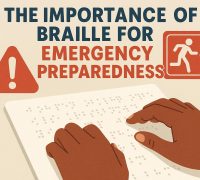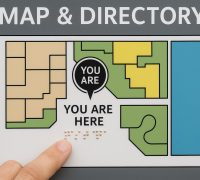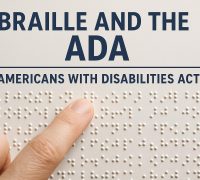The Intersection of Braille and Art
The incorporation of Braille into artistic endeavors represents a significant and innovative approach that fundamentally broadens the accessibility and inclusivity of the art world. Braille, a tactile writing system primarily used by blind and visually impaired individuals, consists of patterns of raised dots. Originally developed for reading and writing, its application has traditionally been limited in scope. However, contemporary artists have begun to explore and extend its unique features into the realm of art and creativity, opening exciting new avenues for expression and communication.
Enhancing Accessibility
One of the primary benefits of incorporating Braille into art is the enhancement of accessibility for individuals who are blind or visually impaired. This innovation ensures that art appreciation transcends visual engagement to include experiences that are tactilely meaningful. By integrating Braille into different forms of art, including painting and sculpture, artists can convey messages that resonate on multiple sensory levels, crafting a more inclusive viewing experience. This inclusivity allows a broader audience to interact with and appreciate art, bridging the gap often faced by visually impaired individuals.
Art, in traditional contexts, has largely been an ocular experience. Paintings, photographs, and sculptures cater predominantly to those who can see and interpret visual cues. The integration of Braille challenges this norm, paving the way for art experiences that are not solely dependent on sight. It invites people to engage with art through touch, thereby democratizing the experience and ensuring it is more universally welcoming.
Techniques and Media
A variety of techniques and media have been employed by artists seeking to incorporate Braille into their work, each offering its unique set of challenges and possibilities. For example, some artists choose to create tactile sculptures with Braille directly embedded into the material. This technique allows individuals to ‘read’ the sculpture with their fingers, bringing a dual sensory experience where the tactile complements the visual or, in some cases, replaces it altogether.
Others design intricate paintings that seamlessly incorporate Braille alongside visual imagery. This approach enables viewers to engage with the piece in multiple ways, either by interpreting the visual aspects or by feeling the Braille dots to understand the content. The rise of advanced technologies, such as 3D printing, has further facilitated artists in creating sophisticated and precise Braille patterns as part of their artworks. This technological assistance allows for greater creativity and precision, expanding the potential for artworks that are as insightful as they are accessible.
Beyond Accessibility: Braille as an Art Form
While enhancing accessibility is a critical objective, Braille itself is progressively recognized as a legitimate form of artistic expression. Artists are starting to explore the structured patterns of Braille to delve into themes of communication, perception, and the barriers these create or dissolve. By experimenting with the visual and tactile elements that Braille offers, these artists challenge traditional notions of aesthetic boundaries.
By juxtaposing Braille text with visual imagery, they invite viewers to reflect on the relationship between language and art. This exploration often raises profound questions about how language shapes our understanding and appreciation of art and how art can convey narrative and emotion beyond the limitations of sight.
Notable Artists and Projects
Several artists have been at the forefront, pioneering the integration of Braille in their creative works. These artists, through their innovative practices and projects, have illustrated the immense potential of Braille as both an artistic medium and a means of societal change.
Projects like The History Darkroom create tactile art pieces that exemplify how Braille can be used to build inclusive and thought-provoking art. These works engage diverse audiences by providing layers of meaning that encourage both contemplation and inclusiveness. In a similar vein, The Braille Institute has actively collaborated with different artists to develop works incorporating Braille in inventive ways. These collaborations emphasize the commitment to creating artworks that are accessible while pushing the boundaries of traditional art forms.
Challenges and Considerations
Despite its potential, the use of Braille in art also presents unique challenges. One significant consideration is ensuring that the Braille used is accurate and legible to effectively serve those who rely on it. This often requires artists to possess a firm understanding of the Braille system and collaborate with experts to confirm the correctness of their works.
In addition, there is a need for education among sighted audiences. Appreciating art that incorporates Braille requires an understanding of the context and the significance behind the tactile elements. This necessitates ongoing efforts in education to enhance societal comprehension of Braille, beyond its functional use to include its artistic implications.
The Future of Braille in Art
As awareness of the importance of inclusivity and accessibility continues to grow, the use of Braille in art is likely to expand even further. Artists are continually experimenting with Braille, pushing boundaries and exploring new creative possibilities that were previously unimaginable.
This evolving trend stands to enrich the world of art, ensuring its cultural landscape becomes a tapestry of diverse experiences and expressions. The incorporation of Braille not only fosters a culture of inclusivity but also strengthens the resolve to create environments where art can be a shared experience for all, regardless of physical or sensory abilities.
The future heralds a promising journey for the intersection of Braille and art, one that invites us to rethink who art is for and how it can be experienced and appreciated across the spectrum of human perception. While challenges remain, the potential for art to be a meaningful experience for everyone is a pursuit worth striving for. The ongoing dialogue between artists, communities of blind and visually impaired individuals, and the society at large holds the promise of a richer, more inclusive horizon where art is no longer the exclusive possession of the sighted, but a shared social and cultural endeavor.



